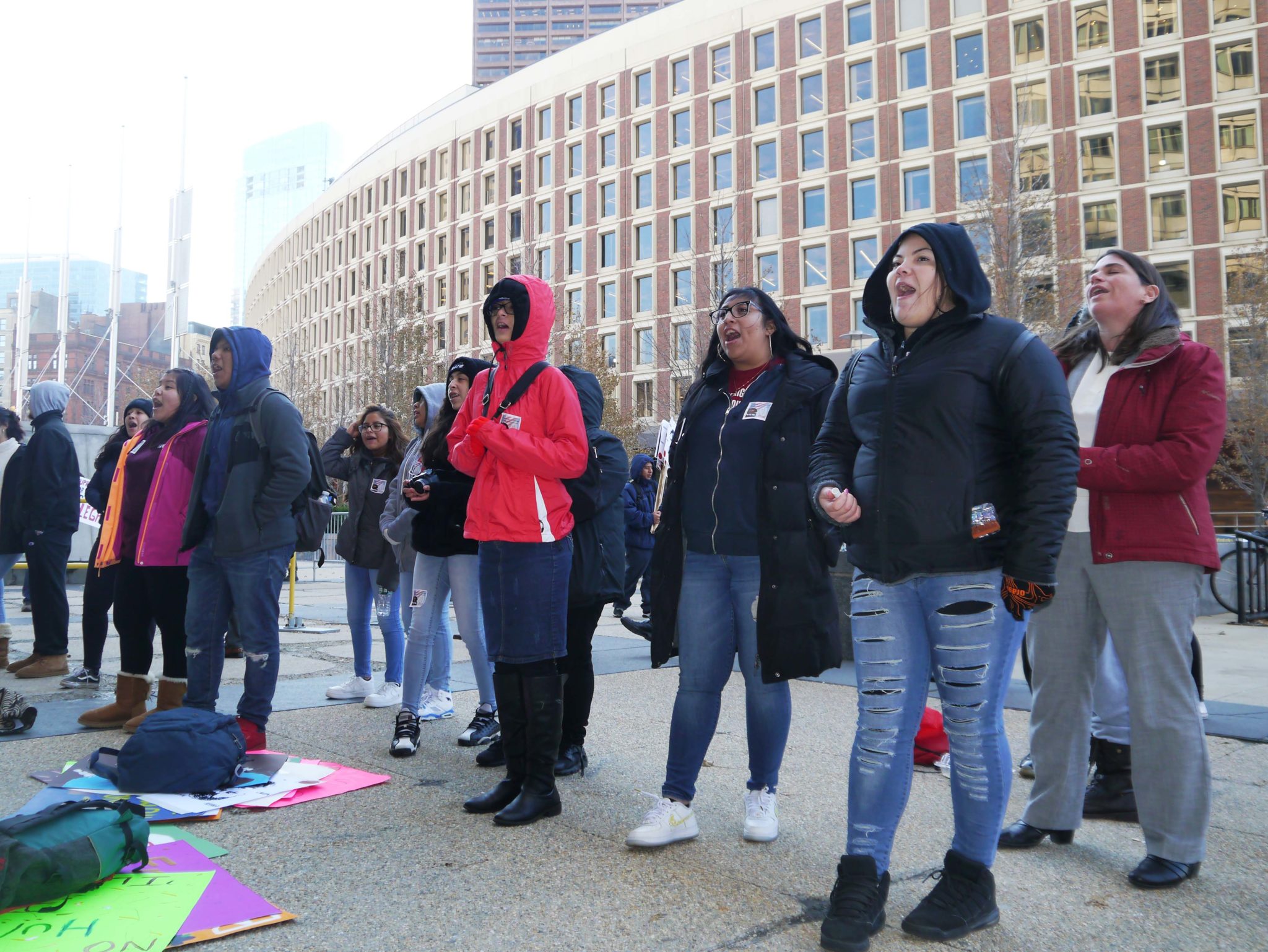
Emiliano Tahui Gomez
Dozens of New Haven residents traveled to Boston on Thursday morning to support an undocumented high school student from the Elm City. The student made a case for asylum during a hearing after spending more than two months in federal custody.
Although protestors expected a final decision on the asylum petition of Mario Aguilar Castañon, a junior at New Haven’s Wilbur Cross High School, they ultimately did not receive an answer. Instead, a federal immigration judge set a date of Dec. 12 to make a final ruling on the teenager’s case. No criminal considerations will be made while an asylum case is in progress. Eighteen-year-old Aguilar Castañon, who immigrated to New Haven from Guatemala in 2018, testified to his case for asylum, emphasizing “fear of return” to his birth country. Federal immigration officials detained Aguilar Castañon as he entered the Milford courthouse to attend a charge of drunk driving in September, and he has remained in custody since.
“There is no reasonable justification for holding [Aguilar Castañon] or anyone else in immigration detention,” Ben Halderman, a staff attorney at the New Haven Legal Aid Association and one of Aguilar Castañon’s lawyers, said after the hearing to protesters who came to support Aguilar Castañon.
Aguilar Castañon’s prolonged detainment comes after the judge refused to grant him a stay of release, declaring him potentially dangerous and a flight risk due to a “lack of connections” in the New Haven Area.
During the hearing, which was held at the John F. Kennedy Federal Building in downtown Boston, Aguilar Castañon’s counsel stressed the grave risks the teenager would face in Guatemala. They described the story of a boy who fled violence and disruptions to his education created by gangs in his native region in Guatemala. Aguilar Castañon, who faced the judge in a set of handcuffs and chains, said he received multiple threats to his life before his arrival to the United States.
Aguilar Castañon, the respondent’s counsel argued, runs a “well-founded fear of persecution” upon return to Guatemala. They told the judge that their client’s status as a young boy and a member of an ethnically indigenous Mayan community — the two factors that gangs look for when recruiting — place him at particular risk to be a victim of continued violence.
Law enforcement in Guatemala, they said, remains unable and unwilling to help their client.
“The Guatemalan government is notoriously inept,” Dalia Fuleihan, another of Aguilar Castañon’s lawyers, argued. “The police force is notoriously ineffective.”
Fuleihan emphasized that Guatemala continues to be politically unstable and said its government kicked the United Nations-backed anti-corruption commission out of the state.
Guatemala remains one of the most violent countries in the world, according to the U.S. Department of State. This violence is aggravated by organized crime groups and gangs. In rural areas, a fear of crime has contributed to a northbound exodus of migrants, particularly among the northern parts of the state. Many of these migrants, like Castañon, are ethnically Mayan.
A lawyer representing federal immigration officials sought to dispel the notion that Aguilar Castañon would face a threat to his life should he to return to Guatemala. The Department of Homeland Security Counsel argued that Aguilar Castañon may not have made sufficient attempts to follow up with police after asking them for help to address threats made against him before fleeing. She also argued that Aguilar Castañon has the ability to resettle somewhere new if he were to return to Guatemala. Aguilar Castañon’s counsel rejected both arguments.
Outside, in the Federal Building plaza, more than three dozen students, protestors and community activists from New Haven protested ICE’s detention of Aguilar Castañon, calling for his release until his final hearing. Protesters also highlighted their larger discontent with ICE and the Department of Homeland Security’s policy of detainment. They demanded the elimination of federal agencies that separate families through deportations and damage immigrant communities.
Classmates of Aguilar Castañon from Wilbur Cross gathered before dawn in front of their high school to make a three-hour bus ride to Boston. Members of Connecticut Students for a Dream, the Connecticut Immigrants Rights Alliance and the Connecticut Bail Fund joined the cohort.
Mia Comulada Breuler, a guidance counselor at Wilbur Cross High School, made the trek out to Boston along with students. She described Aguilar Canstañon as hard-working and well-liked student infatuated with biology — despite the challenges of acclimating to an educational environment in a new country. Breuler attributed his persistence to an understanding that, work and school were “the only way to get ahead.”
Local mobilization around Aguilar Castañon sprung up immediately after his detainment. In October, New Haven residents rallied in front of City Hall to call for his release.
Since then, student groups have written more than 400 letters and made numerous calls to immigrant officials attesting to their classmate’s character and calling for his release.
“We’re going to continue to make noise, to keep the name of Mario present,” said Jesus Morales Sanchez, a community organizer for the Connecticut Immigrants Rights Alliance. “We cannot afford to be quiet.”
The Homeland Security Act passed in November 2002.
Emiliano Tahui Gómez | emiliano.gomez@yale.edu







